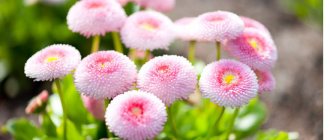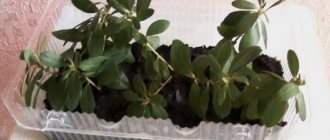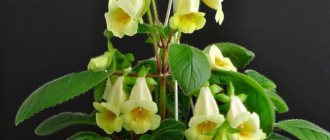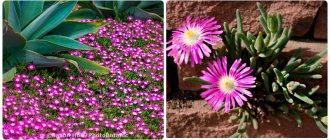Propagation by seeds at home
Euphorbia is propagated by seeds at the end of summer , when seed pods appear, but it can also be sown in the “classical time,” that is, in the spring (the specific time depends on the region and is not related to temperature, but to the length of daylight hours).
Advantages and disadvantages
The method is simple, does not allow preserving varietal characteristics, so it is not suitable for those who plan to propagate plants of a certain variety, and is not so profitable when growing for sale.
How to choose seeds?
Seeds can be collected independently from a crop or purchased in a store . Seeds are taken from a healthy plant; they must be undamaged, not empty, not overdried.
Step-by-step instructions: how to plant?
- The seeds are buried in moist soil; several seeds are placed in one pot.
- The choice of further actions depends on preferences.
Some plant growers claim that subsequent compliance with the microclimate and soil cover is not required, while others recommend creating a microgreenhouse by covering the top of the pot with glass/polyethylene/cut plastic bottle.
How to grow seedlings and when to plant?
Seedlings are grown at normal room temperature, but not lower than 20 degrees with sufficient light. When the first shoots appear, the covering material is removed .
Watering corresponds to the drying of the soil; do not forget that this is not a moisture-loving plant. It is necessary to spray, especially if the room is dry.
Transplantation of seedlings to a permanent place is done when 2-3 leaves appear, when the sprouts have finally become stronger.
Description and characteristics of the plant
Euphorbia, or Euphorbia, has 160 greenhouse species, which differ in the range of flowering and even the type of plant. These are perennial and annual euphorbias, shrubs, herbs, cacti and succulent representatives. Most of them have a fleshy, succulent stem, firmly rooted in the soil. The trunk is straight or ascending, weakly branched, from the mundane type to 2 m in height. Some species are leafless and without thorns, the rest have spines and thorns. The rhizomes are creeping and ascending, and the leaves are found in all types.
Euphorbia most often blooms with monoecious flowers in the spring or in the first half of summer in yellow, light green, pink, red, white, orange (there are also non-flowering representatives). Some species produce fruits in the form of a three-housed nut with seeds. The milky sap has an pungent taste and poisonous properties, so livestock avoid it. The plant is native to the subtropics of Latin America, the tropical zones of the islands of Madagascar and Abd el-Kuri, and archipelagos in the Indian Ocean.
Cuttings
The perennial is propagated by cuttings or by dividing the mother plant in early or mid-spring in order to have time to separate the planting material from the plant before active growth of milkweed begins. The choice of such a time is not accidental - in this way the possibility of a stressful situation can be eliminated, in the light of which the plant could get sick or die.
Some gardeners prefer to divide perennials in early autumn to give the young crop more time to adapt and take root.
Pros and cons of the method
The advantages include the fact that the method makes it possible to preserve the varietal characteristics of the plant in its “new life”; the disadvantages are the need to take a fairly large fragment, which can adversely affect the appearance of the “donor”.
How to prepare cuttings?
Planting material is taken from the healthiest and most beautiful plant . It is better not to touch young plants, but to take cuttings from an adult perennial.
How to root a shoot?
Cuttings are carried out in several steps.
- A shoot at least five centimeters long is taken from a healthy plant. The cut area on the plant does not need to be treated.
- The cuttings can be rooted immediately or allowed to dry for 1-2 days. Rooting is done immediately in a permanent container, so as not to replant and stress the plant later.
- The soil needs to be well moistened (but do not overdo it, otherwise rotting may occur), after which the plant is covered with film or glass to create a microclimate.
- It is necessary to maintain a constant temperature of at least 20 degrees and sufficient lighting. As a rule, rooting occurs after 2-3 weeks.
Growing problems
Due to the caustic, poisonous sap, it is rarely affected by pests. Occasionally it may be attacked by aphids, red spider mites, and mealybugs. Pests are detected by slowing growth, the appearance of plaque, stickiness, cobwebs, and minor damage to the trunk. Insecticides are used to kill pests. Inta-vir and Aktara have proven themselves well. If the number of insects is small, a single treatment is sufficient; if the number of insects is large, at least three treatments are carried out at intervals of 7-10 days. Sometimes problems arise related to care errors or violation of maintenance rules.
How to propagate by dividing a bush?
Euphorbia can also be propagated by dividing the donor plant . In this case, “good health” is also necessary, as well as the presence of several trunks.
As practice shows, separated parts quickly adapt to new conditions and continue development in a separate container.
Advantages and disadvantages of the method
One of the advantages is good survival rate . The disadvantages include the fact that only bush varieties are suitable for this method; in other cases, only propagation by cuttings is suitable.
How to choose and prepare a bush?
No special preparation is required. As in all other cases, it must be an “exemplary in all respects” bush in terms of appearance and condition. Before dividing, the soil is watered; the procedure is carried out carefully so as not to damage the roots and the plants themselves, since some of the varieties are easy to break.
Step-by-step instructions for rooting
The procedure is simple and is performed in several steps.
- An adult euphorbia along with a lump of earth is removed from the pot, excess soil is removed to a minimum, and the condition of the root system is simultaneously checked.
- Then the shoots are carefully separated. It is optimal to take two to four new plants (depending on size and age).
- Each shoot takes root in a separate container with prepared soil of the composition indicated at the beginning of the article. The shoots need some time to recover from stress and adapt to new conditions, so growth will not be as vigorous at first.
What problems may a grower encounter?
Since Euphorbia triangular is an extremely undemanding succulent plant, there are practically no problems when growing it, with the exception of:
- the appearance of brown spots on the lower part of the stem and leaves, which is caused by the development of rot due to a violation of the irrigation regime;
- stretching of stems due to lack of lighting, especially in winter, when natural daylight hours are very short;
- the rapid rate of transformation of an inhabitant of exotic flora into a giant candelabra, which is due to the too spacious pot and the aggressive behavior of Euphorbia triangular when growing the root system with a simultaneous increase in green mass.
Features of breeding in open ground
- Growing euphorbia in open ground will not cause much trouble.
But only garden species of milkweed are suitable for this, and these are mostly perennials. The plant feels good in sunny places and in partial shade, although in the latter case it does not bloom so profusely, so such areas are more suitable for decorative deciduous varieties that can be grown as a “carpet”. - Even indoor spurge propagates well by seeds sown, as a rule, in the spring, and when carried by the wind they easily sprout anywhere in the area.
Having discovered such seedlings, you can dig up the plant and transplant it where you need it, although, despite its unpretentiousness, the plant does not like replanting and takes a long time to adapt, lagging behind bushes sown with seeds in growth. - In warm regions of the country, annual milkweed seeds are sown in early spring, in colder regions - through seedlings or sowing seeds before winter (late autumn), they will undergo natural stratification and grow stronger.
A month after the sprouts appear, the plant can be replanted, or, if sowing was already done in a permanent place, the plantings are thinned out. Planting of finished seedlings in the ground occurs when the threat of frost has passed. When planting using the division method, time does not matter. Some varieties require the installation of a support to which the seedling is tied after planting. The pruning rules are simple, shoots are removed as needed, this will stimulate re-blooming at the end of the season. - The bushes are fed once or twice a season with mineral fertilizers for garden plants, but you can also take those intended for indoor plants. Most varieties of euphorbia tolerate winter well without shelter, but in cold regions it is better to cover the bushes with spruce branches, sawdust, and covering material.
Actions after purchase
While still in the store, carefully inspect the plant, even if it looks healthy on the outside. Look for signs of rot and pests. Alarming signs - spots, softened areas, sticky stems.
At home, immediately “bathe” the flower under a warm shower. Do not place next to other indoor plants. About 2 weeks are allocated for quarantine and adaptation period. After two weeks, transplant the spurge into fresh, suitable soil. During replanting, free the root system as much as possible from the old soil. At first, it is not recommended to apply fertilizers - in stores they actively feed plants to maintain decorativeness.
Photo
Next, you can see in the photo what milkweed flowers look like when properly planted and cared for.
Undoubtedly, spurge is a very original and unusual plant. And every gardener wants to see this handsome man on his windowsill or in the garden. But many people have a question: can it be kept at home, why is spurge dangerous? For those who doubt whether or not to purchase this plant, we have prepared publications about the benefits and harms of milkweed.
General information
It is impossible to describe all euphorbias in one word, since different types of this plant look very different from each other.
Although euphorbia is poisonous, its hardened juice is used for medicinal purposes. Our people treated warts and lichens with milkweed. Hindus use it for snake bites. This plant is also used as a laxative and emetic.
But, if you use it unwisely, in too large doses you can get serious burns and even lose your vision, so we advise you not to resort to treatment (especially on your own) with this plant.
to contents
How to care for the first time?
A plant propagated by any method requires provision of normal conditions. In order for euphorbia to take root faster and actively begin to grow, the location and light parameters must be correctly selected.
Tolerates sunny places well, but without contact with sunlight , but drafts are also undesirable. Window sills on the side with a moderate degree of lighting work well.
If the plant is in the shade, then in winter it may need additional illumination with a phytolamp, but the type of milkweed also matters here; some varieties tolerate the lack of light better, and some - worse, although flowering species may stop blooming in such cases.
Euphorbia does not like excess humidity and abundant watering , this can cause deterioration of the condition. Indoor spurge should be watered more only during the period of active growth and if the air in the room is dry, and garden species - in dry summers.
The same applies to spraying. Excess moisture can be recognized by a change in color to a paler color and a decrease in the number of leaves.
However, complete drying out of the soil should also not be allowed . There are no strict temperature requirements; the plant tolerates a wide range of temperatures (from 16 to 24), however, sudden changes should be avoided.
In the warm season, you can keep it on the balcony, terrace, veranda, but you should not take the spurge there during the hot period, you need to accustom it to street conditions gradually.
A young plant needs periodic feeding.
The optimal solution is a complex fertilizer for succulents , which can be used year-round. Feeding is carried out no more than once every two months in winter and autumn, once a month in spring and summer.
Garden species are fed twice or thrice a season with mineral fertilizers.
In autumn, it is recommended to mulch plants (peat, humus, sawdust), and in cold regions to cover them for the winter (spruce branches, covering material, polyethylene, etc.). The need for pruning depends on the variety.
Correct pruning allows you to form a beautiful crown and increase the lushness of the bush, but if you have no experience in this matter, then it is better not to experiment, otherwise the plant will have to be thrown away, since it is difficult to correct unsuccessful pruning of milkweed due to the not very lush crown.
Faded buds and dried leaves must be removed . Young plants are replanted annually, each time increasing the volume of the pot.
The soil is selected depending on the variety, but the variations in composition are not too different. Both flowering and decorative foliage varieties can be grown in a universal substrate. It is recommended to replant adult plants every three to four years. Rooting is most effective in the spring.
All the features of caring for milkweed are described in detail in this article.
As a conclusion, we can say that growing milkweed is not difficult (if only for beginners), but it looks quite attractive and will fit harmoniously into any interior, and there is a place for it in the garden that it will transform.
Euphorbia favorites
The extensive family of Euphorbiaceae is enormous. According to various sources, there are about two thousand of them. But what is most striking is the species diversity. There is everything here: from trees to cacti. We will limit ourselves to descriptions and photos of only the most spectacular and famous species.
- Euphorbia triangularis (Euphorium triangularis). It got its name because of the clearly defined edges on the stems. It is considered one of the fastest growing and drought-resistant. In the wild it grows up to two meters in height.
- Euphorbia Mile. The second name is Crown of Thorns. Due to its ability to quickly cover large areas of land with lush bushes with fairly large flowers, in southern latitudes it is used for landscaping personal plots. Came to us from Western Europe, where it has been known since the end of the 19th century. The Mili flower is very beautiful: soft pink, with slightly bent rounded petals.
- Euphorbia white-veined (Euphorium white-veined). The main decoration is large bright green leaves with white veins. Does not tolerate dry air well. With the start of the heating season, regularly wipe the leaves with a damp sponge.
- Euphorbia fringed is a resident of the mountainous areas of North America. In comfortable conditions, it is capable of covering a significant area in the spring, forming dense thickets. Just like other related species, it is unpretentious and does not require special care.
- Myrtifolia differs from its many relatives in being somewhat demanding in terms of microenvironmental conditions. The point is the quality of the soil: this low perennial will grow and develop well only on calcareous soils. Otherwise, the requirements are similar to general recommendations.
- Euphorbia Pallas is a wild species, popularly known under another name: Male root. It is interesting from the point of view of the medicinal properties of all its components, especially the root. For more information about the benefits of this amazing plant, watch the video.
The main signs of malaria
It is impossible to give a definite description of the plants of the Euphorbia family, due to their absolute dissimilarity. The stem is usually erect, although some species have no stem at all. The leaves can be oblong, large or small, sometimes mixed with spines. Some types of milkweed are very similar to cacti and have a large number of needles instead of leaves, or, like succulents, have no foliage.
Many representatives of milkweeds do not bloom or the flowers look like tiny inflorescences surrounded by covering foliage. There are plants that bloom brightly and densely, some of them have an unusual spike-shaped inflorescence.











